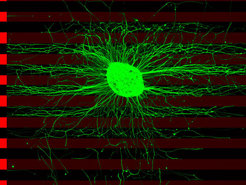Navigation for nerve cells
FLRT proteins direct precursors of pyramidal cells to their destination by attractant and repellent signals
During brain development, the precursors of nerve cells sometimes have to migrate long distances from their place of origin to their destination. In this process, proteins, such as FLRTs (pronounced “flirts”), act as guide molecules. Researchers at the Max Planck Institute of Neurobiology in Martinsried, together with colleagues at the Universities of Oxford and Frankfurt have now discovered that FLRT proteins on the surface of progenitor cells can induce repellent and attractant signals depending on its binding partner. The scientists used X-ray crystallography to reveal the structural bases for both FLRT-mediated adhesion and repulsion. They applied this knowledge to elucidate how these opposed signals control cellular migration. Which signal predominates depends on the particular type of cell migration. The results further show that FLRTs also exert attractant and repellent effects in the walls of blood vessels and therefore control the development of other tissue types as well.

Pyramidal cells are the central nerve cells in the cerebral cortex. During embryonic development, the precursors of pyramidal cells follow the paths of glial cell axons to migrate from their original location to the surface of the cerebral cortex. As soon as they reach their intended layer, they develop into mature pyramidal cells and interlink to form a functional network. Pyramidal cells also spread to a limited extent within these layers, though the importance of such tangential migration is still poorly understood.
This migration of precursor pyramidal cells is controlled by FLRTs (fibronectin-leucine-rich transmembrane proteins) located on the cell surface. According to the researchers at the Max Planck Institute in Martinsried, FLRTs and the Unc5 receptor form a group of guidance proteins with opposing effects on cell migration. On one hand, they act as a repellent. This is the case when a FLRT molecule binds to an Unc5 receptor on the surface of a progenitor cell. “In this way, as the precursor cell migrates radially, it receives a signal to continue migrating at an adjusted speed to not move prematurely into outer layers,” explains Rüdiger Klein from the Max Planck Institute of Neurobiology.
However, if two identical FLRT molecules bind to each other, this triggers an adhesive signal. The scientists’ results show that pyramidal cells are guided in this manner as they spread tangentially, without affecting their ability to find their target layer. Thus, there are proteins with attractant and repellent effects located on the surface of precursor pyramidal cells. “By integrating these opposing signals, cells can navigate through brain tissue. During radial migration FLRTs induce repulsion; during tangential dispersion FLRT attraction dominates,” says Klein.
In their study the scientists also investigated whether the mechanisms of FLRT adhesion and repulsion are present in other cell types. Their findings show that cells in the walls of blood vessels in the retina and the umbilical cord are also controlled by a combination of attractant and repellent signals modulated by FLRT and Unc5 proteins.
SM/HR-DU












